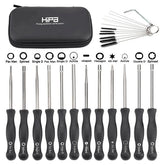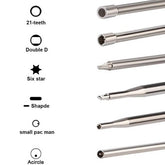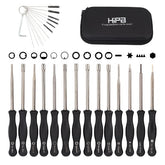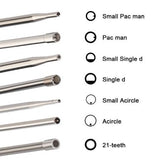Adjusting Carburetor Settings for Maximum Power and Efficiency in 2-Cycle Small Engines
25 May 2023
0 Comments
When it comes to small engines, such as those found in lawn mowers, generators, and other outdoor power equipment, the carburetor plays a crucial role in delivering the right mixture of fuel and air to the engine. However, over time, the carburetor may need adjustment to ensure optimal power and efficiency. In this blog, we will discuss the steps involved in adjusting carburetor settings for maximum power and efficiency in small engines.
Before we begin, it's important to note that carburetor adjustment can be complex, and if done incorrectly, can cause damage to the engine. Therefore, it's recommended that you consult the engine manufacturer's instructions or a qualified technician if you're unsure about any of the steps involved.
Step 1: Locate the Carburetor
The first step in adjusting the carburetor is to locate it on your small engine. The carburetor is typically located near the engine air filter and is connected to the fuel line. Once you've located the carburetor, you can move on to the next step.
Step 2: Adjust the Idle Speed
The idle speed is the speed at which the engine runs when it's not under load. To adjust the idle speed, you'll need to locate the idle speed screw on the carburetor. Turn the screw clockwise to increase the idle speed and counterclockwise to decrease it. The goal is to adjust the idle speed to the manufacturer's recommended setting.
Step 3: Adjust the Air-Fuel Mixture
The air-fuel mixture determines the ratio of air to fuel that enters the engine. An incorrect mixture can cause the engine to run poorly, either running too rich (too much fuel) or too lean (too little fuel). To adjust the air-fuel mixture, you'll need to locate the mixture screw on the carburetor. Turning the screw clockwise will make the mixture richer, while turning it counterclockwise will make it leaner. Again, refer to the manufacturer's instructions for the recommended setting.
Step 4: Adjust the High-Speed Setting
The high-speed setting controls the engine's performance at full throttle. To adjust the high-speed setting, you'll need to locate the high-speed screw on the carburetor. Turn the screw clockwise to increase the engine's speed at full throttle and counterclockwise to decrease it. It's important to note that adjusting the high-speed setting can affect the air-fuel mixture, so you may need to make adjustments to the mixture screw as well.
Step 5: Test and Fine-Tune
Once you've made adjustments to the idle speed, air-fuel mixture, and high-speed setting, it's time to test the engine's performance. Start the engine and let it warm up for a few minutes, then test it at various speeds and under different loads. If the engine is running smoothly and has good power, you're done. However, if you notice any issues, such as sputtering or loss of power, you may need to fine-tune the settings.
Final Thoughts
Adjusting the carburetor settings for maximum power and efficiency in small engines can be a complex process, but it's essential for optimal performance. If you're unsure about any of the steps involved or don't feel comfortable doing it yourself, it's always best to consult the manufacturer's instructions or a qualified technician. With proper adjustment, your small engine can run smoothly and efficiently, giving you years of reliable service.
Before we begin, it's important to note that carburetor adjustment can be complex, and if done incorrectly, can cause damage to the engine. Therefore, it's recommended that you consult the engine manufacturer's instructions or a qualified technician if you're unsure about any of the steps involved.
Step 1: Locate the Carburetor
The first step in adjusting the carburetor is to locate it on your small engine. The carburetor is typically located near the engine air filter and is connected to the fuel line. Once you've located the carburetor, you can move on to the next step.
Step 2: Adjust the Idle Speed
The idle speed is the speed at which the engine runs when it's not under load. To adjust the idle speed, you'll need to locate the idle speed screw on the carburetor. Turn the screw clockwise to increase the idle speed and counterclockwise to decrease it. The goal is to adjust the idle speed to the manufacturer's recommended setting.
Step 3: Adjust the Air-Fuel Mixture
The air-fuel mixture determines the ratio of air to fuel that enters the engine. An incorrect mixture can cause the engine to run poorly, either running too rich (too much fuel) or too lean (too little fuel). To adjust the air-fuel mixture, you'll need to locate the mixture screw on the carburetor. Turning the screw clockwise will make the mixture richer, while turning it counterclockwise will make it leaner. Again, refer to the manufacturer's instructions for the recommended setting.
Step 4: Adjust the High-Speed Setting
The high-speed setting controls the engine's performance at full throttle. To adjust the high-speed setting, you'll need to locate the high-speed screw on the carburetor. Turn the screw clockwise to increase the engine's speed at full throttle and counterclockwise to decrease it. It's important to note that adjusting the high-speed setting can affect the air-fuel mixture, so you may need to make adjustments to the mixture screw as well.
Step 5: Test and Fine-Tune
Once you've made adjustments to the idle speed, air-fuel mixture, and high-speed setting, it's time to test the engine's performance. Start the engine and let it warm up for a few minutes, then test it at various speeds and under different loads. If the engine is running smoothly and has good power, you're done. However, if you notice any issues, such as sputtering or loss of power, you may need to fine-tune the settings.
Final Thoughts
Adjusting the carburetor settings for maximum power and efficiency in small engines can be a complex process, but it's essential for optimal performance. If you're unsure about any of the steps involved or don't feel comfortable doing it yourself, it's always best to consult the manufacturer's instructions or a qualified technician. With proper adjustment, your small engine can run smoothly and efficiently, giving you years of reliable service.





















